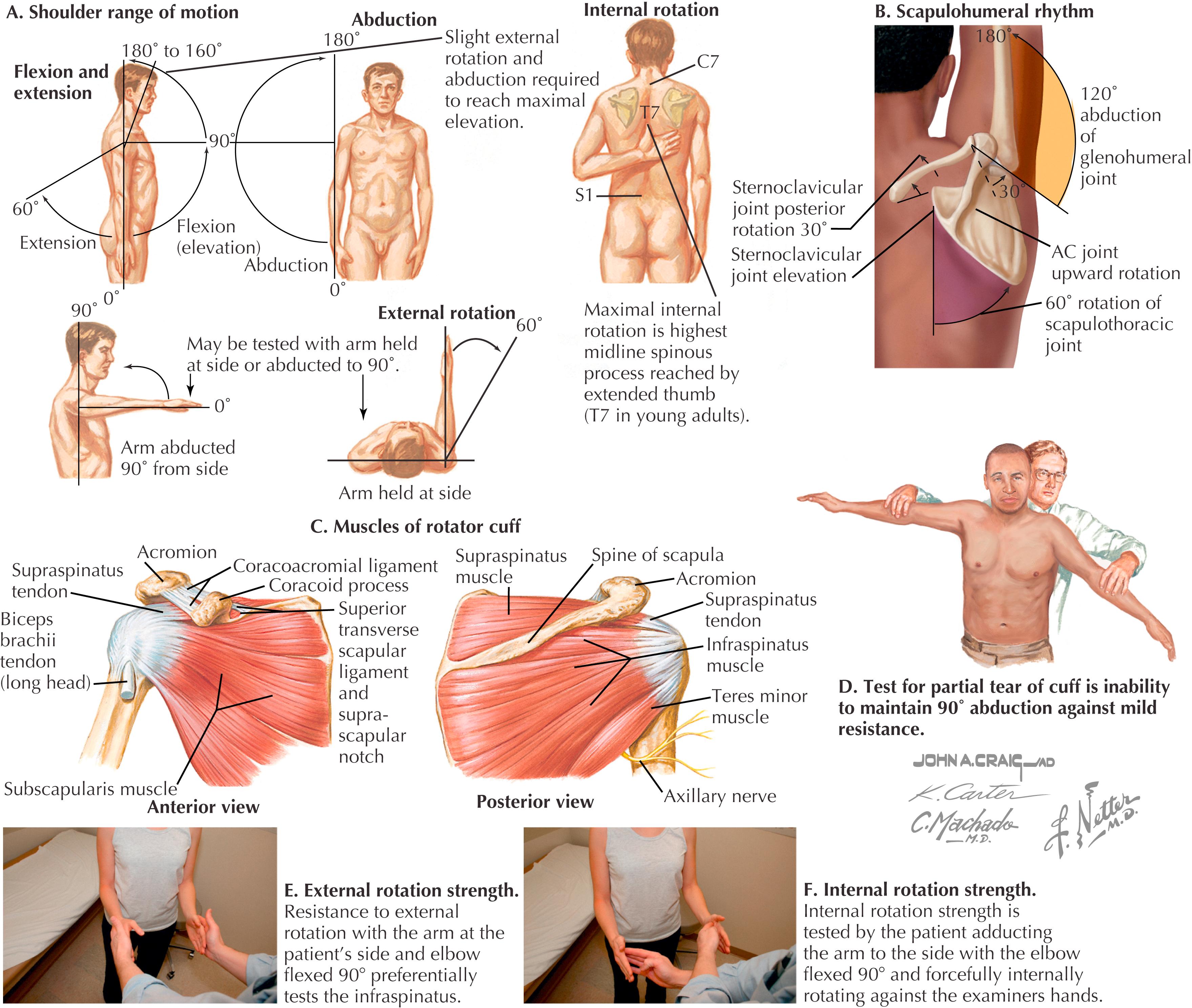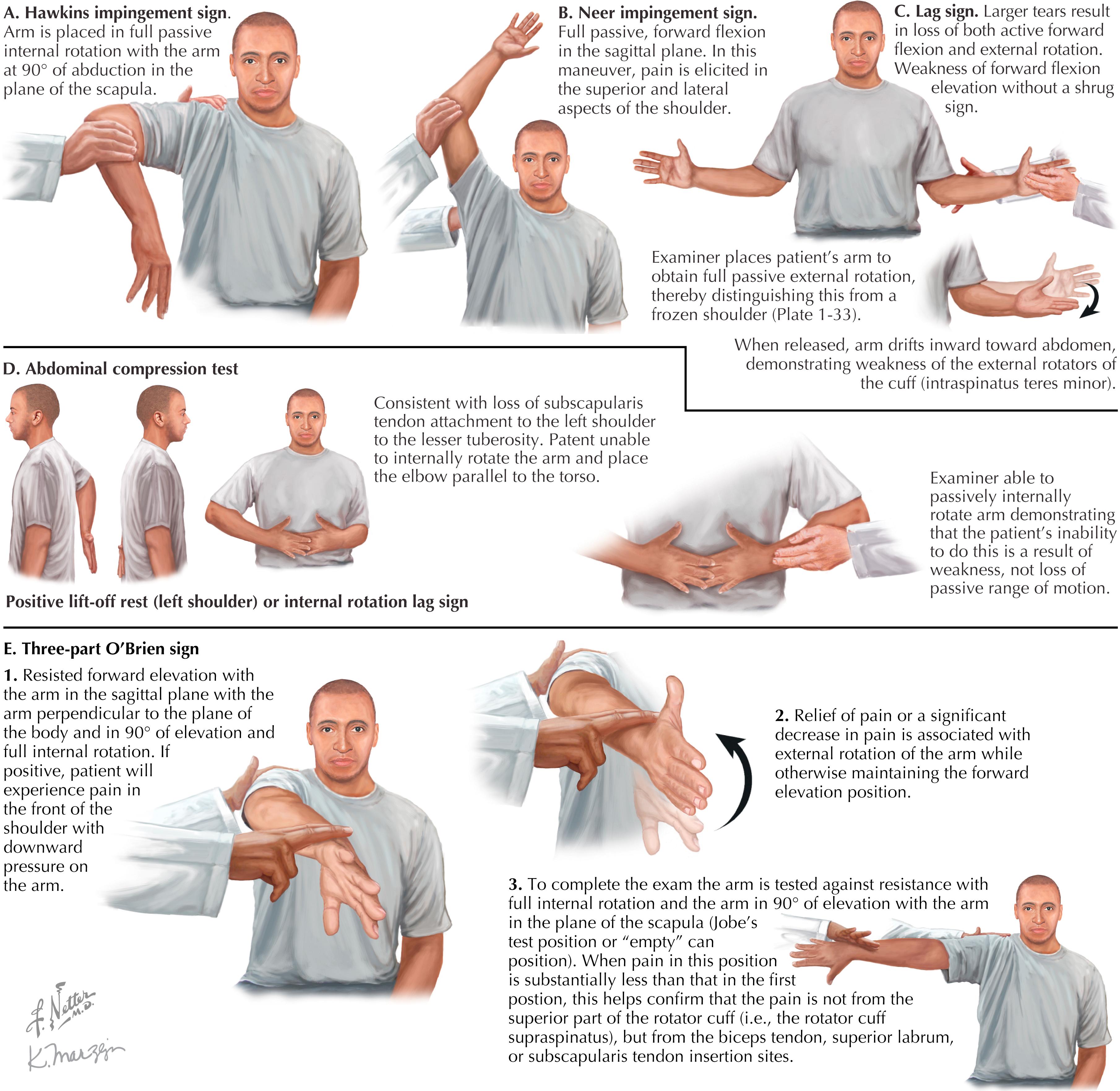Physical Address
304 North Cardinal St.
Dorchester Center, MA 02124
The authors would like to acknowledge the work of Charles T. Crellin, MD, and Kevin M. Honig, MD, for their contribution to the previous edition.
A careful history will help establish the diagnosis and formulate a treatment plan.
Important factors include the chief complaint, mechanism of injury, hand dominance, what sport the athlete plays, and prior treatments.
Common complaints are “pain with overhead activities,” “loss of range of motion,” “pain at night when I lie on that side,” and “a feeling of the shoulder coming out of the joint.”
Evaluation of shoulder pathology should include an examination of the cervical spine to rule out referred pain.
It is important to visualize the entire shoulder during an examination and compare it with the unaffected side (including the scapula).
Check for muscle atrophy, which can indicate neurologic dysfunction or chronic injury.
Examine for scapular dyskinesia or winging.
Note bony prominence that could represent acromioclavicular (AC) separation, clavicle fracture, sternoclavicular (SC) subluxation, or degenerative disease.
Palpate bony landmarks for tenderness or crepitus—AC joint, clavicle, SC joint, greater tuberosity, and coracoid.
Extension and internal rotation of the arm deliver a greater tuberosity from under the acromion.
It is important to compare active and passive range of motion with the unaffected side. Forward flexion, abduction, and external rotation are measured in degrees from neutral rotation. Internal rotation is measured in relation to the spinal level that can be reached posteriorly ( Fig. 49.1A ).

Does motion cause pain or produce a feeling of instability?
The normal ratio of glenohumeral (GH) to scapulothoracic motion is 2:1 (see Fig. 49.1B ).
Supraspinatus: (Jobe test) Resistance is applied with the patient’s arm abducted 90 degrees, forward flexed 30 degrees, and internally rotated (thumb pointing down).
Infraspinatus/teres minor: Resistance to external rotation with the arm adducted and the elbow preferentially flexed 90 degrees assesses the infraspinatus. Resistance to external rotation with the arm abducted and the elbow flexed 90 degrees assesses both the infraspinatus and teres minor (see Fig. 49.1 ).
Subscapularis: Resistance to internal rotation with the arm adducted and the elbow flexed 90 degrees (see Fig. 49.1F )
Positive tests produce pain at the anterior or lateral aspect of the shoulder.
Hawkins test: The arm is passively forward flexed to 90 degrees and then forcibly internally rotated ( Fig. 49.2A ).

Neer sign: The patient’s arm, with the forearm pronated, is passively forward flexed while the scapula is stabilized (see Fig. 49.2B ).
Painful arc: The patient actively elevates the arm in the scapular plane and then lowers it in the same plane. Pain during range of motion between 60 and 120 degrees is positive.
Coracoid impingement sign: The patient’s arm is passively placed in a position of forward flexion, adduction, and internal rotation with pain produced directly over the coracoid.
Jobe test: Isolates the supraspinatus (see earlier discussion); pain can also be indicative of subacromial impingement
Champagne toast: The arm is abducted against resistance at 30 degrees of abduction, 30 degrees of forward flexion, and mild external rotation; this test isolates the supraspinatus.
Drop arm sign: The patient fully elevates the arm in the plane of the scapula and then tries to lower it slowly. Sudden dropping of the arm or pain while doing so suggests a supraspinatus tear.
External rotation lag sign: With the arm adducted and the elbow flexed 90 degrees, the arm is passively brought to maximal external rotation. Inability of the patient to actively maintain the arm in the externally rotated position indicates a massive tear involving the infraspinatus (see Fig. 49.2C ).
Lift-off test: The dorsum of the patient’s hand is placed against the lumbar spine (see Fig. 49.2D ). The patient then lifts the hand away from the back, maintaining the elbow in the coronal plane. Inability to do so indicates a lower subscapularis tear.
Belly-press test: The patient places both hands on the abdomen, internally rotates to bring the elbows forward beyond the coronal plane, and then presses the hands into the abdomen. Inability to move the elbow beyond the coronal plane indicates an upper subscapularis tear (see Fig. 49.2D ).
Hornblower sign: The patient is asked to hold the arm in a 90-degree abduction and a 90-degree external rotation. A positive sign, wherein the arm falls into internal rotation, represents a teres minor pathology.
Speed test: With the forearm supinated and the elbow extended, the patient forward flexes the arm against resistance. A positive test produces anterior shoulder pain.
Yergason test: With the elbow in 90 degrees of flexion, the patient supinates the forearm against a resistive force. A positive test produces pain in the biceps region.
Upper cut test: With the elbow in 90 degrees of flexion and the forearm supinated, an upward and cross-body motion is performed against resistance. A positive test will induce pain.
It is important to perform these tests on the contralateral extremity for comparison and assessment of the patient’s normal laxity.
Apprehension test: Best performed supine (table stabilizes the scapula); the arm is passively abducted to 90 degrees and then progressively externally rotated while the patient’s response is noted. A positive test produces a patient response of “apprehension” by reproducing the patient’s symptoms of anterior instability.
Relocation test: A posteriorly directed force is applied to the proximal humerus while performing the apprehension test. The test is positive when the patient’s “apprehension” is relieved and greater external rotation can be achieved. Note: If the apprehension test produces pain (as opposed to a feeling of instability) that is relieved by the relocation test , it is suggestive of internal impingement (Jobe relocation test).
Load and shift test: The humeral head is loaded to center it within the glenoid. It is then translated anteriorly and posteriorly. The amount of translation is graded as follows: grade 0, minimal; grade I, up to the rim of the glenoid; grade II, over the glenoid rim but spontaneously reduces; or grade III, over the glenoid rim and does not spontaneously reduce.
Load and shift test: See previous discussion.
Posterior stress test: Performed supine; the arm is flexed to 90 degrees and internally rotated. A posteriorly directed force is then applied to the humerus. A positive test causes subluxation.
Jerk test: Performed upright; the arm and the elbow are flexed 90 degrees. The arm is internally rotated and the humerus is loaded posteriorly. A positive test can cause posterior subluxation of the humeral head that is then reduced with a “jerk” when extending the arm.
Sulcus sign: Traction is applied to the arm in an inferior direction while observing the area lateral to the acromion for a “sulcus.” Presence of a sulcus >1 cm indicates inferior laxity.
Clunk test: Performed supine; the arm is fully abducted, and the examiner’s hand is placed on the posterior aspect of the humeral head. An anterior force is applied to the humerus, while the other hand rotates the humerus. Positive findings include a “clunk,” pain, and grinding.
O’Brien test (active compression test): The arm is positioned in 90 degrees of flexion and 10–15 degrees of adduction. A downward force is applied by the examiner as the patient resists, first with the arm internally rotated (thumb down) and then with the arm externally rotated (thumb up). A positive test causes pain felt deep within the joint that is reduced or relieved with the arm externally rotated, which indicates superior/posterior labral pathology (see Fig. 49.2D ).
Kim test: Performed upright; with the arm in a 90-degree abduction, a strong axial load is applied. While the arm is elevated to 45 degrees upward and diagonally, a downward and backward force is applied. A positive test is sudden onset of posterior shoulder pain, which indicates a posteroinferior labral lesion.
Biceps load test: Performed supine; the arm is abducted 120 degrees, maximally externally rotated, the forearm supinated, and the elbow flexed 90 degrees. Active elbow flexion is then performed against resistance. A positive test produces pain suggestive of a superior labrum anterior and posterior (SLAP) tear.
Anterior slide test: The patient’s hands are placed on the hips with the thumbs pointing posteriorly. An axial load is applied at the elbow toward the GH joint against patient resistance. A positive test produces pain suggestive of a SLAP tear.
Modified dynamic labral shear: The arm is flexed 90 degrees at the elbow, abducted in the scapular plane to above 120 degrees, and externally rotated to tightness. The arm is then lowered from a 120- to a 60-degree abduction, keeping the arm maximally externally rotated. A positive test produces pain or a painful click and indicates superior labral pathology.
Become a Clinical Tree membership for Full access and enjoy Unlimited articles
If you are a member. Log in here